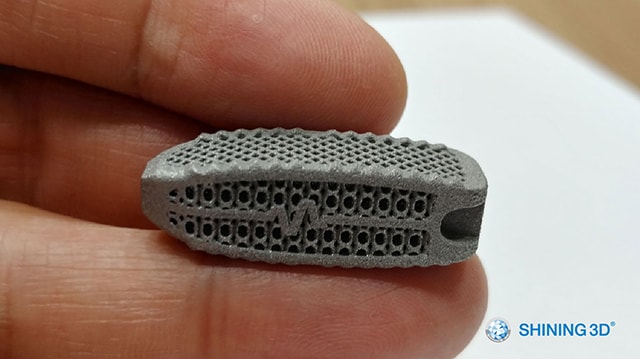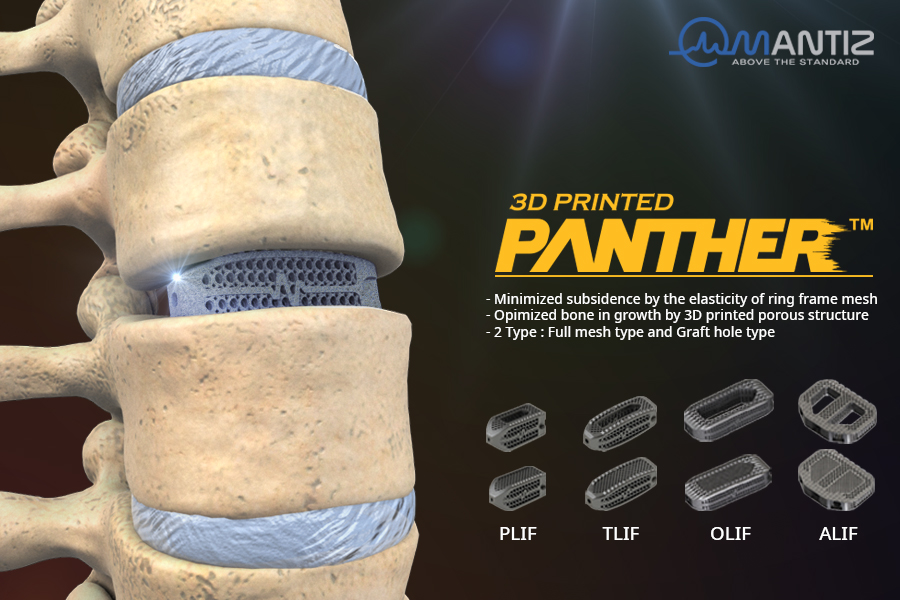Leading Chinese 3D printer, 3D scanner, and electronic device manufacturer Shining 3D Tech. Co., Ltd, has shared that its partner, Mantiz, is using Shining 3D machines to produce medical implants.
Headquartered in Daegu, South Korea, Mantiz is a specialist producer of spinal implants. The PANTHER, a range of interbody fusion cages for implantation at various positions along the spine, is one of the company’s latest releases, and is manufactured using 3D printing.
“We have completed the development of [an] improved titanium 3D printed cage implant using [the] EP-M250 metal 3D printer,” disclosed Mantiz CTO Hongwon Yoon in a recent announcement. “The mechanical test results prove the safety and functionality of our implants.”

Mantiz 3D printed medical implants
Active in the medical implant market since 2014, Mantiz offers a range of 6 different products, including a range of medical screws, and minimally invasive metal supports for the spine. The 3D printed PANTHER line of interbody fusion cages is the company’s most recent launch, becoming commercially available in May 2019.
There are eight different variants of the PANTHER spinal cage, specific to the direction from which they are inserted. The Posterior Lumbar Interbody Fusion (PLIF) PANTHER implant, for example, is a device designed to be implanted from the back of the spine. A Transforaminal Lumbar Interbody Fusion (TLIF) implant, on the other hand, is implanted from the side. Each one also comes structured either with a full mesh or a graft hole in the middle, depending on the needs of the patient.

One of the benefits of 3D printed spinal cages, is that they can be produced with an internal lattice-like structure. In studies, such structures have shown to encourage the regrowth of bone cells as they mimic the texture of cancellous tissue, found at the end of long bones. As with many 3D printed spinal cages, Mantiz’s PANTHER cages too have a mesh-like internal structure.
“The average closed porosity of 3D printed titanium solid part is 3%,” explains Yoon. “[This] leads to accelerated protein and mesenchymal stem cell attachment for bone fusion.”
In-house additive manufacturing
Manufacturing on Demand
Mantiz has a Shining 3D EP-M250 metal 3D printer in-house for the production of its PANTHER range of medical implants. Harnessing powder bed fusion technology, the EP-M250 is a selective laser melting (SLM) system added to Shining’s system portfolio after its acquisition of fellow Chinese company E-Plus 3D in 2016.
The EP-M250 is capable of processing a range of metals, including stainless steel, maraging steel, nickel-based alloy, titanium alloy, cobalt-chromium alloy, aluminum alloy and copper alloy. It has an optional, single-laser power of 200 w or 500 w, and produces scanning speeds of 8 m/s.
Within the machine’s build volume of 262 x 262 x 350mm, Mantiz is capable of producing up to 50 PANTHER cages in a single operation.

Medical device market consolidation
Operating in the 3D printed spinal device market, Mantiz is amongst fierce competition, that has been beginning to witness some consolidation.
Osseus Fusion Systems, Nexxt Spine, K2M and Emerging Implant Technologies GmbH (EIT) are all companies to have attained FDA approval for their 3D printed spinal fusion devices. EIT, however, is now part of Johnson & Johnson Medical’s growing 3D printing portfolio, and K2M was the subject of a multibillion-dollar deal by leading medical technology firm Stryker in 2018. Further, with the acquisition of K2M, Stryker now states that it has “the largest portfolio of 3D printed cages on the market.”
* This article is reprinted from 3D Printing Industry. If you are involved in infringement, please contact us to delete it.
Author: Beau Jackson

Leave A Comment